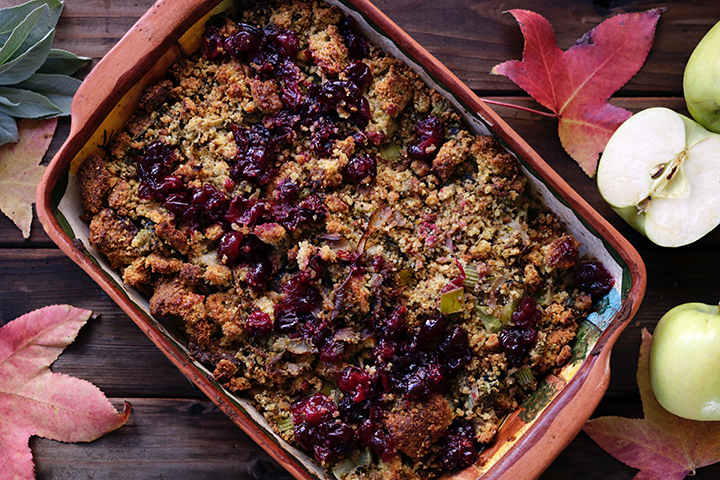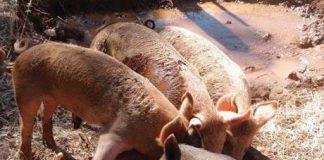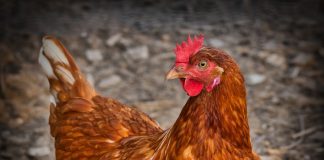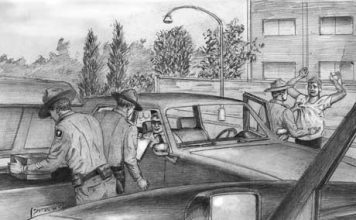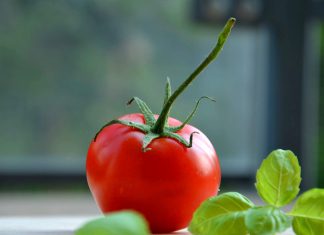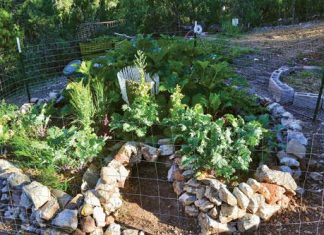 |
|
| Issue #30 • November/December, 1994 |
Oftentimes, I stop and wonder what people ate in the early days of this country. We cooks do that sometimes. And it’s at times like this that I often remem ber how, years ago while I still worked with and was being trained by old Sully, he spoke several times about Thomas Jefferson and the influence he had on improving food served at the White House. He often joked that he thought Jefferson’s main reason for becoming President was so he could eat and serve guests gourmet foods made by professional chefs. When he said things like that, they didn’t mean much to me until years later, after cooking French, Italian, Chinese, and other dishes and I started asking myself, “Exactly what is American Food?” I knew it wasn’t hot dogs, Big Macs, and take-out chicken.
So, in my spare time, I set out to get an answer to my question. In the end, I found there was no simple answer to what I initially believed was a simple question.
What I found, however, was that over the centuries there have been many contributions to “American” foods that not only made interesting eating but interesting reading as well. I’m going to share some of the things I’ve learned, and by the time we reach the end of this article I’ll discuss some ideas and recipes that concern the most “American” meal I can think of–Thanksgiving.
But I should tell you that even with this original American meal, there are things that may surprise you. Turkey is now the established main course served on this wonderful family day, but it apparently wasn’t even on the menu that first Thanksgiving dinner in 1621. From what the Pilgrims themselves wrote about the first Thanksgiving dinner, it consisted of venison, roast duck, roast goose, eels, and clams for entrees. There’s no report of turkey being served. What had been served, however, was a significant improvement over what they had been eating. For, up until the harvest, the travelers on the Mayflower had been living on salt horse (actually dried beef; I don’t know why they called it salt horse), hardtack, beer, dried fish, and cheese.
English influences
For years to come, most of the settlers in the eastern part of America came from England or the English colonies and their tastes in food reflected this. At that time, British tastes called for a limited amount of seasoning. The seasonings that were available were pepper, mace, clove, and ginger. And that was in Europe. In the New World colonies, even those seasonings were available only to the luckiest or wealthiest families. For the most part food in this part of the world could, at its best, only be considered as fair and unimaginative.
The American Indians
However, to make use of some of the native fair in North America, English housewives started to draw upon the centuries of experience the Indians had acquired using native plants and meats. And the Indians taught them a great deal. Indian cooking placed a great emphasis on the many uses of corn. The colonists were quick to learn the value of cornmeal as well as wheat flour to make their breads and gradually many fine and lasting recipes emerged. Johnny cake, corn pones, hoe cakes, hush puppies, and hawg’n’hominy (a mixture of hulled dry corn cooked with salt pork) are just a few examples. Another corn dish the Indians made, one they called msickquatash, included dried beans. They shared this dish with the Pilgrims who quickly developed about 12 variations as it spread across the country. Today we call it succotash.
Another secret they shared with the Pilgrims, but which we have little regard for today, is that corn should be cooked within an hour of being picked. Nowadays we know this is because 90% of the sugar in corn turns to starch in a short time. The Indians, and later the Pilgrims, boiled their water in the fields so they could cook and eat ripened corn as soon as it was picked. When’s the last time you did that? If you have your own garden or know where you can buy fresh picked corn and have it cooked within an hour, I strongly recommend you give it a try. You’re not going to be disappointed.
The development of “American” food seemed to be on a good track for a number of years, but sometime during the late 1700s, it started to get some mixed reviews. Here are a couple of examples of some of what was happening. In 1796, the first truly American cookbook, called American Cookery, was published. The author was listed as “An American Orphan.” Her real name was Amelia Simmons. The book was published in four editions and gave the first professional directions for making Indian pudding and johnny cake. An American mode of cooking can be seen when later editions presented recipes that included Independence Cake and Federal Cake.
Food was available in great variety and abundance during this time. A visitor to a New York city market recorded 63 kinds of fish, 14 varieties of mollusks and shellfish, 52 types of meat and poultry, and 27 kinds of fresh garden vegetables. Compare this inventory with that of your local market today. Unfortunately this abundance did not promote culinary excellence. An English seagoing novelist, visiting this country during this period said, “God sends the meat, the devil sends the cooks,” and “plenty of good things for the table in America, but . . .” And the “but” was not flattering. This bad reputation continued until French and Spanish influences were felt.
French influences
In the beginning, French haute cuisine and the Puritan English did not get along very well, and French culinary sophistication had little influence in this country for a long time. But the seeds of change had been planted. A Virginian named Thomas Jefferson followed Ben Franklin as U.S. envoy to France and spent five years in Paris. He became addicted to French food, and when he became President he hired the first French chef to serve in the White House. By 1896 the slow but consistent blending of French food concepts in this country became apparent when a cookbook, The Boston Cooking School Cookbook by Fannie Merritt Farmer, was published. This book described the meaning of cooking as the capacity to combine English thoroughness with French art. This proved to have a great influence on what American food was to become.
Spanish influences
However, that was in the east. The French had little influence in the southwestern and western parts of the new country. There, the Spanish influence was felt, all the way from Florida to the coast of California. The Spanish brought hot peppers, like cayenne and Tabasco, north–culinary delights they had pilfered from the Indians of Mexico, Central and South America. In Louisiana, the use of these peppers, in combination with another indigenous vegetable, the tomato, became the standard formula to change standard recipes into Creole variations. Bean dishes–the bean is another native plant–are characteristic of the Spanish influence on American food. Foods like chili and guacamole (made from the avocado, a native fruit) were also brought here by them. Today, guacamole is so popular in this country that dictionaries now recognize the word as a part of our language.
Barbacoais a Spanish word first applied in the New World after Spanish explorers had observed the outdoor grilling of meat by Haitian and North American Indians. The English adapted the word as barbecue.
As the Spanish developed their successful ranchos in New Mexico and Arizona, they further developed and refined the techniques of the barbecue. Many barbecue sauces were developed by them at this time and they’re still popular across this country today.
Pennsylvania
Germany has also contributed a great deal to “American” food. The Pennsylvania Dutch (actually, Deutsche) are ancestors of German speaking refugees who came here from the Rhineland and other parts of German speaking Europe. Also settling into Pennsylvania were the Quakers from England and Wales, the Amish from Switzerland, as well as many others. It did not take long for the word to spread that good food was to be had in Pennsylvania. If you have ever had a sample of good sausage scrapple with your breakfast, you know what I am talking about. My mother was born and raised in Altoona, PA, so I can tell you that these folks brought good food ideas to this country.
By the way, one thing Jefferson could not convince people of, and which was not widely recognized until years after his death, was that the tomato was a versatile and nutritious food source. Back then, there were those who thought tomatoes were poisonous. Among its other names was “the devil’s plum.” In the early nineteenth century Pennsylvanians added tomatoes to succotash, and that variation became a popular standard.
If I can ever get my mother to give me some of her Pennsylvania recipes, I’ll share them with you. She has a recipe for hot potato salad that is wonderful.
The African connection
You’ve probably never heard anyone cite the contributions the African slave made to “American” food. Let me be the first to tell you about them. Nowadays, it is common to describe what the slaves ate as “soul food.” It was poor people’s food–but it was good food. It came about because, back in the 1800s, while the rest of America was entering its era of food abundance, the plenitude was not available to the slaves. What they often subsisted on was what their masters would not eat. In spite of this, they made lasting contributions to the way we eat.
When the slave ships landed, they brought more than just the slaves. They also brought some unique African cooking traditions. For example, one of the foods familiar to the slaves was the peanut. A century before the English settled in North America, African cooks were using peanuts in their cooking. These legumes had arrived on the African continent aboard Spanish ships which had brought them to the Guinea Coast and the Congo.
To the slave, brought here in chains and strangers on a continent they didn’t even know had existed, the peanut was a familiar sight, so one of the first things they shared with cooks of European ancestry was how to cook with it. Soon after the first slaves appeared in American kitchens, the first soups made with peanuts were served. I have heard that peanut soup is to Virginia what bean soup is to Boston. Later, thanks to George Washington Carver, a man who had once himself been a slave, the peanut became a standard source of food to almost everyone in the world.
But the inventiveness of the black cook goes beyond peanuts. Poverty made it necessary for them to rely on items that were in great supply but of little use to others. Pig fat was one such item and the black cooks developed a talent for deep fat frying. All varieties of fish were cleaned and coated with corn meal and fried to a crisp state. My grandmother fried mackerel so crisp you could snap it in half and eat the fish bones and all. Do yourself a favor; give it a try.
Sesame seeds were already familiar to cooks with European backgrounds, but black cooks did things the Europeans never thought of. Sesame was known on the Niger River in Africa as “benne.” Once they were brought here, slaves would pound sesame seeds into a paste, as they had done in Africa, and they mixed it with hominy, for both the flavor and nutritive value. By substituting them for peanuts and combining them with oysters, they also developed an interesting cream soup that is enjoyed even today.
Few other American cooks, then or now, know more about the barbecuing of wild game than the experienced black cook. This is probably because, quite often, meats like possum, squirrel, and raccoon were all that was available to them. Today, however, examples of the early negro recipes for these are hard to find.
The cooking methods developed by the slaves were good, simple, and required no frills, but they were so consistent that if you eat fried chitterlings or candied yams in New York City or San Francisco today, they are the same as anywhere in the South, today or 150 years ago.
The Italians
Between the end of the nineteenth century and the beginning of World War II, Americans “naturalized” Italian food. Italian restaurants have been around at least since 1849 in California. There, during the Gold Rush, you could get a good tomato and pasta dish in most mining towns. Ever since, Italian food has continued to gain popularity. Sometime before World War I, Kansas farmers started growing durum wheat, the type of wheat necessary for making good pasta. At about that same time, canning companies began producing canned tomato sauces. The lasting influence of this taste in food was sealed.
Many talented Italian farmers settled on the west coast. This greatly influenced the produce industry and did much to influence “American” food. The first commercial growing of bell peppers, eggplants, broccoli, and many other vegetables can be traced to Italian farmers. Most of us have our favorite Italian recipe or restaurant. In my house, when we’re looking for good food that’s reasonably priced, Italian often comes to mind.
The religious societies
The nineteenth century seems to be a time when America’s food experienced many changes and sophistications. Breakfast foods, as we know them today, were the result of a series of events that happened during this period. Many religious societies were started during this time with the idea of improving their member’s lifestyles. One of the earliest was the Shaking Quakers. Basic and wholesome food was one of their primary tenets. They advocated the increased consumption of fruits and vegetables and less use of meat. They were among the first in this country to use the whole wheat kernel when grinding flour. They actively protested the removal of the live germ from the kernel by commercial mills. These protests were supported by a young man in Connecticut named Sylvester Graham. A Presbyterian minister, Graham preached that all bread should be cooked at home and baked with whole wheat flour. This didn’t make him popular with commercial bakers, and on more than one occasion he required police protection to hold meetings.
He attracted many followers. People like Bronson Alcott–father of Louisa May Alcott, the author of Little Women–were influenced by Graham’s preachings. Leaders of the Seventh Day Adventists also adopted many of Graham’s food ideas. This set in motion some interesting events:
The Seventh Day Adventists, in Battle Creek, Michigan, believed that any Adventist who suffered indigestion should be treated in a private sanitarium. To this end they awarded a medical scholarship to a man named John Henry Kellogg, and the Battle Creek impact on the American diet was set in motion. Kellogg had some strong ideas about breakfast foods. Two years after he was put in charge of the Seventh Day Adventist health sanitarium, he developed the first Battle Creek health food–Granola.
Another supporter of Graham’s food ideas was a chronic dyspeptic named Henry Perky. Perky owned a vegetarian restaurant in Colorado and, in his spare time, developed what we know today as Shredded Wheat.
Meanwhile, one of Dr. Kellogg’s patients at the sanitarium, C.W. Post, developed another breakfast cereal that today we call Grape Nuts. Kellogg and Post started the breakfast food industry and both died very wealthy men.
Other food pioneers
Another man, Gustav W. Swift, helped develop the use of refrigerated trains to ship beef across the country, and as a result fresh meat was available on American tables anytime of the year.
Early in the 1900s, another man, Clarence Birdseye, quit his government job to perfect a fast freezing method to preserve food for commercial purposes.
This century also saw the development of commercial canning in France. But after it was brought to this country, Americans quickly began canning more food than all the rest of the world combined.
There are many other countries, religions, and individuals that have made significant contributions to what has become “American” food, and the process continues to this very today. To cover everything, I would need about 200 more pages, and as soon as I was finished the article would be obsolete because the process keeps going on.
In future articles I will cover foods from Greece, Japan, and the Scandinavian countries. But as you can see, although there is no cuisine that can be distinctively identified as “American,” we have somehow created a multiplicity of foods that now form the American food experience. I believe this is what makes cooking in this country so interesting and in part explains why the art of cooking has attracted talent such as Julia Child, Craig Claiborn, Paul Prudhomme, and James Beard, just to name a few. I hope to be sharing with you my ongoing answer to the question, “What is American food?” for a long time to come.
It’s recipe time and the most American food I can think of is served on Thanksgiving Day. Here are some of my family favorites.
Roast turkey with johnny cake and sausage stuffing
Everything served in our house on this day is made from scratch, so I carefully check inventories on the weekend before, so that I will not be caught short on a day when most stores are closed. Make sure you have an ample supply of homemade stocks.
Johnny cake:
This is a cornmeal bread that, in combination with the sausage recipe that follows, forms the basis of this stuffing but both the johnny cake and the sausage can be served alone or used in other dishes.
Ingredients:
1 cup flour
3 Tbsp sugar
2 Tbsp baking powder
½ tsp salt
1 cup yellow corn meal
2 eggs
1 cup whole milk
2 Tbsp melted butter
1 Tbsp bacon fat
Method:
1. Mix together flour, sugar, baking powder, salt, and corn meal.
2. In a separate bowl beat the eggs and mix them with the milk, butter, and bacon fat. Now add this to the flour and mix gently with a wooden spoon until liquid is incorporated. Be careful not to over mix. This batter does not have to be lump free.
3. Grease a 9×9 inch baking pan, then evenly spread the batter in the pan.
4. Place in a preheated 400 degree oven and bake for about 45 minutes.
5. Remove from the oven and set aside to cool.
Homemade sausage:
(This should be prepared the day before.)
Ingredients:
12 oz rindless salt pork diced into 1 inch pieces
2 lbs lean pork diced into 1 inch pieces
½ lb smoked ham (whatever you prefer, I like Cure 81)
¼ cup brandy (I like Apple Jack)
½ tsp ground nutmeg
¼ tsp ground mace
½ tsp summer savory
½ tsp dried thyme leaves
¼ tsp allspice
½ tsp fresh ground white pepper
½ tsp dried basil leaves
Method:
1. Simmer the salt pork in water for 5 minutes and drain.
2. Pass the pork, smoked ham, and salt pork through the coarse screen on your meat grinder, then through the fine screen. If you do not have a meat grinder, I strongly recommend that you get one before attempting this recipe.
3. Place the ground meat in your mixer’s largest bowl and incorporate the remaining ingredients using the paddle.
4. Saute a small amount of the sausage and taste it. Adjust the seasoning to meet your tastes.
5. Cover and refrigerate overnight. This allows the seasoning flavors to penetrate.
Stuffing:
Ingredients:
1 lb fresh homemade sausage
¾ cup diced Granny Smith apples (peeled and cored)
2 cups chopped onions
¼ cup chopped celery
½ cup diced walnuts that have been lightly browned in the oven
2 tsp marjoram
1 tsp dried thyme
1 Tbsp dried sage
½ tsp Fennel seed
1 tsp salt
¼ tsp nutmeg
7 cups johnny cake diced into 1/2-inch chunks
2 eggs well beaten
4 oz butter or margarine
2 cloves fresh garlic finely minced
Method:
1. Saute the sausage over medium heat until all the pink color is gone. Remove the cooked sausage from the pan and set it aside. Leave the fat in the pan.
2. Add the apples, onions, and celery to the pan and saute over medium heat until soft. Remove from the pan and drain off the excess fat.
3. Combine the walnuts, marjoram, thyme, sage, fennel seed, salt, and nutmeg with the sausage.
4. Combine sausage mixture with the johnny cake and the cooked apple-onion-celery mixture, lightly mix and stir in the beaten eggs.
5. The mixture should be moist but not heavily wet. If more moisture is needed, use your homemade chicken or turkey stock to moisten to your satisfaction.
Stuffing and roasting the turkey:
Ingredients:
1 18 to 20 lb Bird
1 qt. water
1 medium onion
2 carrots
2 stalks of celery
1 bay leaf
salt and freshly ground pepper
Method:
1. Remove the neck along with the liver, gizzard, and heart and place them in a sauce pan with about 1 quart of water, 1 medium onion cut into quarters, 2 carrots that have been cut into quarters, 2 celery stalks cut into one inch pieces, and a bay leaf. Simmer this, covered, over a low heat for about an hour. The result will be a broth you can use for your gravy. You will be using your own gravy recipe but this gives the entree your personal touch.
2. Wash the turkey then dry it, inside and out, with paper towels. Rub the inside of the turkey with a light sprinkle of salt and fresh ground black pepper.
3. Stuff the neck cavity with about 2 cups of stuffing. Pull the neck skin back and fasten it to the turkey’s back with skewers.
4. With the breast side up, fold the wing tips under turkey and stuff the main cavity with about 6 to 7 cups of stuffing. Do not pack tightly, it should remain loose. Before placing the bird in the oven, cover the exposed stuffing with a heel of bread or aluminum foil. This will keep it from drying out while the turkey is roasting.
5. Tie the drum sticks and the tail together with twine.
6. Rub the outside of the bird with softened butter.
7. Preheat the oven to 325 degrees. Place the turkey on a roasting rack and put it in a suitable size roasting pan. Now place the turkey in the oven, breast side up.
8. Roast the turkey for 4 to 5 hours.
9. Test doneness by sticking a fork in the thickest part of the thigh. If the juices run clear the turkey is done. If using a meat thermometer, stick it in the same part of the thigh without touching the bone. When the thermometer reads 180 degrees the bird is done.
10. Remove the bird from the oven and allow it to rest for 30 minutes before carving.
Glazed carrots with peas and onions
This is a favorite in my family anytime of the year and it’s quick to make.
Ingredients:
1-½ lbs. sliced fresh carrots
1-½ cups chicken or beef broth
6 Tbsp butter
½ cup diced fresh onions
1 tsp brown sugar
2 tsp honey
1-½ cups fresh or frozen peas
½ tsp salt
½ tsp freshly ground black pepper
Method:
1. Simmer the carrots in the broth over medium heat until just tender. Drain and reserve the broth.
2. Melt the butter in a suitable size skillet and saute the onions over medium heat until tender.
3. Add the brown sugar, honey, and ¼ cup of the reserved broth and stir until the sugar is dissolved. Add the carrots and peas and continue to saute until the vegetables are glazed.
4. Add the salt and pepper and serve.
Here are 2 pie recipes that have become favorites with my family on holidays. They are both made in a 9″ pie dish and use my Never Fail Crust recipe.
Never Fail Crust
The following crust is for the two pie recipes that follow. Ingredients:
3 cups all purpose flour
½ tsp salt
1 cup shortening
9 Tbsp ice cold water
Method:
1. Measure the flour into a mixing bowl by scooping the flour from the container and leveling to the top of the measuring cup. It is not necessary to sift.
2. Add the salt and mix well.
3. Using a pastry blender or two knives, cut the shortening into the flour until the mixture looks like a bunch of little balls the size of small peas. To spite what many so called pros will tell you, this can also be completed very efficiently using your fingers. You must work quickly though. Remember that shortening melts next to heat and your fingers mean heat.
4. Add the ice water to the flour mixture and press the mixture until the flour absorbs the water and forms a moist ball then press this ball together with your fingers keeping in mind that your fingers still mean heat, so don’t hold this ball for a long time. The less the dough is handled, the more flaky and tender it will be.
5. Place the dough in the refrigerator to chill for about 30 minutes.
6. Divide the dough into two balls, making one ball slightly larger than the other. This larger ball will be the bottom crust.
7. Roll the larger ball on a lightly floured counter into a circle about 1/8 inch thick and 2 inches larger than the size of the pie dish. Now fold the crust in half (this makes it easier to lift and move), place it in the pie dish then unfold it to fit the dish.
8. Gently press the dough to fit the contour of the pie dish. There will be about one inch of the dough hanging over the dish. Lift this up and fold it in half to make a standing rim around the pie dish.
9. Roll the second ball of dough to the same thickness but only about 1″ larger than the pie dish.
There you have my Never Fail Pie Crust.
Now for the pies.
Blueberry pie
Wild blueberries are found in Europe and North America. Cultivated blueberries were developed in New Jersey and are the most available blueberry today. This is a favorite fruit in my house. The following recipe is my wife’s “Birthday Cake.”
Ingredients:
6 Tbsp margarine or butter
5 Tbsp all purpose flour
1-¾ cup sugar
½ tsp salt
½ tsp fresh ground nutmeg
2 tsp quick cooking tapioca
1 Tbsp lemon juice
6 cups fresh or frozen blueberries
1 Never Fail Pie Crust
1 egg, lightly beaten
Method:
1. Place the margarine or butter in a small sauce pan and set on a medium heat to melt. After this melts, stir in the flour to make a smooth paste. Cook this paste while stirring for about 5 minutes. Remove from the heat and allow to cool. You have created a flour roux.
2. Combine sugar, salt, nutmeg, tapioca, and lemon juice and mix with a spoon.
3. Add the flour roux to the sugar mixture and mix well.
4. Combine this mixture with the blueberries and mix very gently. Try not to break the berries.
5. Preheat your oven to 375 degrees.
6. Follow the recipe for preparing and rolling the pie crust and place the bottom crust in your pie dish.
7. Spread the filling evenly in the pie dish.
8. Carefully fold the top crust in half and place it evenly over half of the pie dish, then unfold it to cover the other half. Now seal the two crusts together by fluting the outer edge of the crust with your fingers. Fluting is simply a process of crimping the dough together by pressing with your fingers or a fork. Trim off any excess crust with a knife.
9. Cut 4 X’s around the pie and one in the middle.
10. Brush the crust with the lightly beaten egg and place in the preheated oven to bake for about 45 minutes to an hour. The pie is ready to come out when the crust is evenly browned and the filling is bubbling in the middle.
Old fashioned apple pie
This is my favorite food. To me, this “is” American food, Amen.
Use tart, crisp, and fresh apples when preparing this recipe. I use Cortlands, Granny Smiths, or Macouns. You will need about 10 apples that are peeled and cored to get the 2 lbs. required for this recipe.
Ingredients:
3 Tbsp butter
2 Tbsp flour
1-¼ cups sugar
1 tsp cinnamon
¼ tsp nutmeg
1 tsp salt
1 tsp lemon juice
2 lbs sliced fresh apples
Method:
1. Melt the butter in a small sauce pan over a medium heat. Add the flour and cook, while stirring, for about 5 minutes. Remove from the heat and set aside to cool.
2. Combine the sugar, cinnamon, nutmeg, salt, and lemon juice. Mix thoroughly, then add the flour paste and mix again.
3. Toss this mixture with the sliced apples and set aside while you prepare your crust.
4. Spread the filling evenly in the pie dish and follow the same procedure outlined for the blueberry pie. This pie may require more or less time in the oven, depending on the condition of the apples. Older apples are soft and cook faster.
Well, that’s it folks. I’ll catch you next issue and we’ll continue our ongoing journey through the American food experience.


